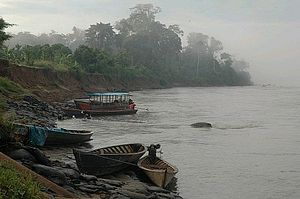| Madre de Dios River | |
|---|---|
 Madre de Dios near Boca Manu town, Peru | |
 The Amazon Basin with the Madre de Dios River highlighted | |
| Location | |
| Country | Bolivia, Peru |
| Physical characteristics | |
| Source | |
| • location | Cordillera Vilcanota, Peru |
| • coordinates | 12°53′17.0808″S 71°21′36.1944″W / 12.888078000°S 71.360054000°W |
| Mouth | Madeira River |
• location | Villa Bella, Beni, Bolivia |
• coordinates | 10°22′53.1156″S 65°23′28.9968″W / 10.381421000°S 65.391388000°W |
• elevation | 105 m (344 ft) |
| Length | 1,347 km (837 mi) |
| Basin size | 281,000 km2 (108,000 sq mi)[1] to 310,000 km2 (120,000 sq mi)[2] |
| Discharge | |
| • location | Near mouth |
| • average | (Period: 1985–2013)9,350 m3/s (330,000 cu ft/s)[1] (Period: 1973–1990)10,140 m3/s (358,000 cu ft/s)[2] |
| • minimum | 2,970 m3/s (105,000 cu ft/s)[1] |
| • maximum | 17,800 m3/s (630,000 cu ft/s)[1] |
| Discharge | |
| • location | Miraflores–El Sena |
| • average | (Period: 1985–2013)5,800 m3/s (200,000 cu ft/s)[1] |
| • minimum | 2,250 m3/s (79,000 cu ft/s)[1] |
| • maximum | 10,300 m3/s (360,000 cu ft/s)[1] |
| Basin features | |
| Progression | Madeira → Amazon → Atlantic Ocean |
| River system | Amazon |
| Tributaries | |
| • left | Manu, Los Amigos, Las Piedras, Orthon |
| • right | Chivile, Azul, Colorado, Inambari, Tambopata, Heath, Beni |
The Madre de Dios River (Spanish pronunciation: [ˈmaðɾe ðe ðjos]) is a river shared by Bolivia and Peru which is homonymous to the Peruvian region it runs through. On Bolivian territory, it receives the Beni River, close to the town of Riberalta, which later joins with the Mamore River to become the Madeira River after the confluence. The Madeira is a tributary to the Amazon River.
The Madre de Dios is an important waterway for the department of Madre de Dios, particularly Puerto Maldonado, the largest town in the area, and the capital of the department. Mango farming and gold mining are among the many industries on its banks. Other important industries the Madre de Dios provides are selective logging and farming, both of which are serious environmental problems. Along the length of the river, there are several national parks and reserves, notably Tambopata-Candamo National Park, Manu National Park (also known as Manu Biosphere Reserve) and Bahuaja-Sonene National Park.
- ^ a b c d e f g Molina-Carpio, Jorge; Espinoza, Jhan Carlo; Vauchel, Philippe; Ronchail, Josyane; Gutierrez Caloir, Beatriz; Guyot, Jean-Loup; Noriega, Luis (2017). "Hydroclimatology of the Upper Madeira River basin: Spatio-temporal variability and trends". Hydrological Sciences Journal. 62 (6): 911–927. doi:10.1080/02626667.2016.1267861. S2CID 133578964.
- ^ a b "HYDROLOGIE DU BASSIN AMAZONIEN" (PDF). 1997. ISBN 2-7011-1532-9.